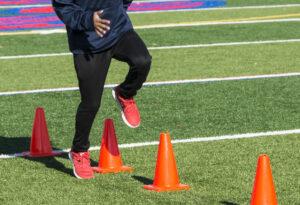
Most of us have fallen into a repetitive workout routine. This makes sense! Once you find something that makes you feel good, why not stick to it? You may be a spin class enthusiast, a runner, a weightlifter, a hiker, or a fan of low-impact exercises like Yoga. While you should definitely stick to what you love, it is important to shake up your routine every now and again in order to maximize your results and work different parts of the body in different ways.
Enter: Plyometrics.
Plyometric training is one of the most frequently overlooked forms of exercise (and is a physio fan favourite)! It involves bounding, jumping, kicking, throwing, running, push-ups, and other forms of rapid force production. Oftentimes, people perceive that plyometric exercises are mainly beneficial for serious power athletes, but plyometrics are advantageous for nearly everyone.
Benefits of Plyometrics:
No matter how fit you are or what sport of choice you focus on, there are valuable benefits of plyometrics. Adding a couple plyometric exercises to your weekly workout routine can dramatically advance your fitness with minimal time invested.
Plyometrics challenge your muscles, bones, and connective tissues along with your neuromuscular and cardiovascular systems. Some benefits of plyometrics include:

- Increased heart rate.
We often assume that cardiovascular exercises like swimming, running, rowing, and elliptical trainers are the only way to improve your cardio fitness. However, resistance exercises like squats and jumping exercises like plyometrics are also effective means to boost your cardiovascular health. When completing these exercises, your heart rate will quickly increase, and you’ll likely feel your lungs burning after a tough set of burpees or box jumps. Strengthening your heart and lungs is a great way to reduce your risk of heart disease, stroke, and high blood pressure.
- Burn calories.
If you are looking for exercises to help achieve your weight loss goals, plyometrics are a great place to start! Most plyometric exercises are full-body movements which means that you burn significant calories in a short period of time. Exercises that require every major muscle to be recruited at once tend to be metabolically demanding. The increased heart rate also means that you’ll continue to burn calories long after your workout is complete (called excess post-exercise oxygen consumption).
- Increases muscle strength.
In simple words, plyometrics will make you stronger. They train your muscles to develop more force because they harness the power of the point in the muscle stretch cycle where maximum contractile force can be produced. Essentially, with plyometrics, you rapidly move between eccentrically contracting (lengthening) a muscle and concentrically contracting (shortening) it. This works to develop greater force and trains your neuromuscular system to recruit muscle fibers more rapidly.
- Efficient.
Plyometrics are the ideal exercises for HIIT (high-intensity interval training) workouts. HIIT workouts are so desirable because people experience impressive fitness progress in far less time than that of moderate-intensity exercise.
Fun fact: HIIT workouts that incorporate plyometric exercises can accomplish equivalent workout results as an aerobic endurance workout in only one third to half the time!
- Improves athletic performance.
If you are a tennis player, marathoner, hiker, hockey player, skier, and more, plyometrics is sure to only improve your athletic performance. Since plyometric training is an intense full-body workout, this supplementary training will help you lift heavier, run faster, jump higher, and generally develop more power in your body. Plyometric training works your anaerobic system, increases your cardiovascular fitness, and builds your strength more efficiently than bodyweight exercises.
- Improves coordination.
The majority of plyometric exercises are repetitive and involve simultaneous movements of the upper body and legs. This works to train your neuromuscular system to integrate movement patterns, which ultimately improves coordination and balance.
- Strengthens bones and joints
Since plyometric exercises are high-impact in nature, they are an ideal way to strengthen connective tissues like tendons and ligaments and increase bone density. Your musculoskeletal structures must absorb the impact of landing, which stimulates the body to develop more structural support. In this way, consistent plyometric training can make your body more resilient so that you are less likely to get injured. (A physio plus)!
- Suits all fitness levels.
The intensity of plyometric exercises can be modified to suit your fitness level and needs. For example, an athlete may be able to take on weighted box jumps, whereas someone recovering from injury may try gentle skipping or marching in place.
- Can be done anywhere!
Though some specific plyometric exercises require equipment, most can be done with just your body weight. Burpees, tuck jumps, bounding drills, and jump rope are all examples of functional plyometric exercises that get your heart pounding and muscles working with just your body weight — no gym required!
Plyometrics exercise you can try:
Now that we have established all the reasons why you should try adding plyometrics to your workout routine, let’s quickly dive into what plyometric exercises you can utilize! Group together any of the following exercises to make an great plyometrics workout:
- Jump rope
- Push-ups
- Tuck jumps
- Box jumps
- Alternating jumping lunges
- Mountain climbers
- Burpees
- Lunges
- Lateral bounds
Get moving with Synergy Rehab!
If you are unsure how to start incorporating plyometrics into your weekly workout routine, come schedule an appointment with one of our expert physiotherapists! We will help ensure that your body is functioning properly so you can get stronger with no risk of injury.
Keep in mind that plyometrics isn’t for you if you’re pregnant. Your belly’s growing size will throw off your balance or you could fall or get injured. The weight of your growing baby stresses your knees and ankles, and jumping adds even more stress. Ligaments that help stabilize your joints grow a little laxer during pregnancy, making injuries more likely. Choose our pre/post-natal physiotherapy if you are looking how to safely move your body while pregnant!
If you have any physical limitations, choose other strength-building exercises that will be safer for you.








